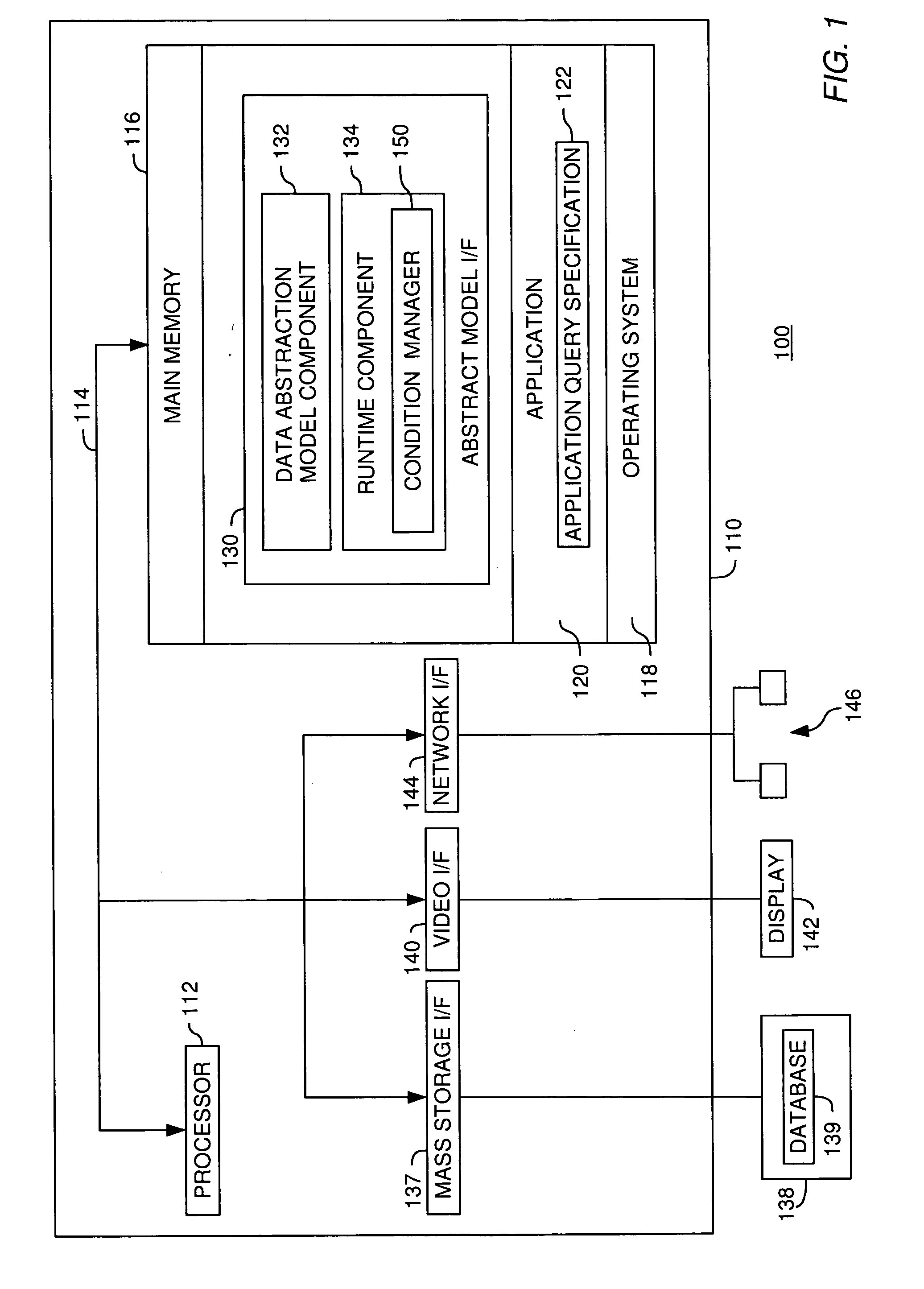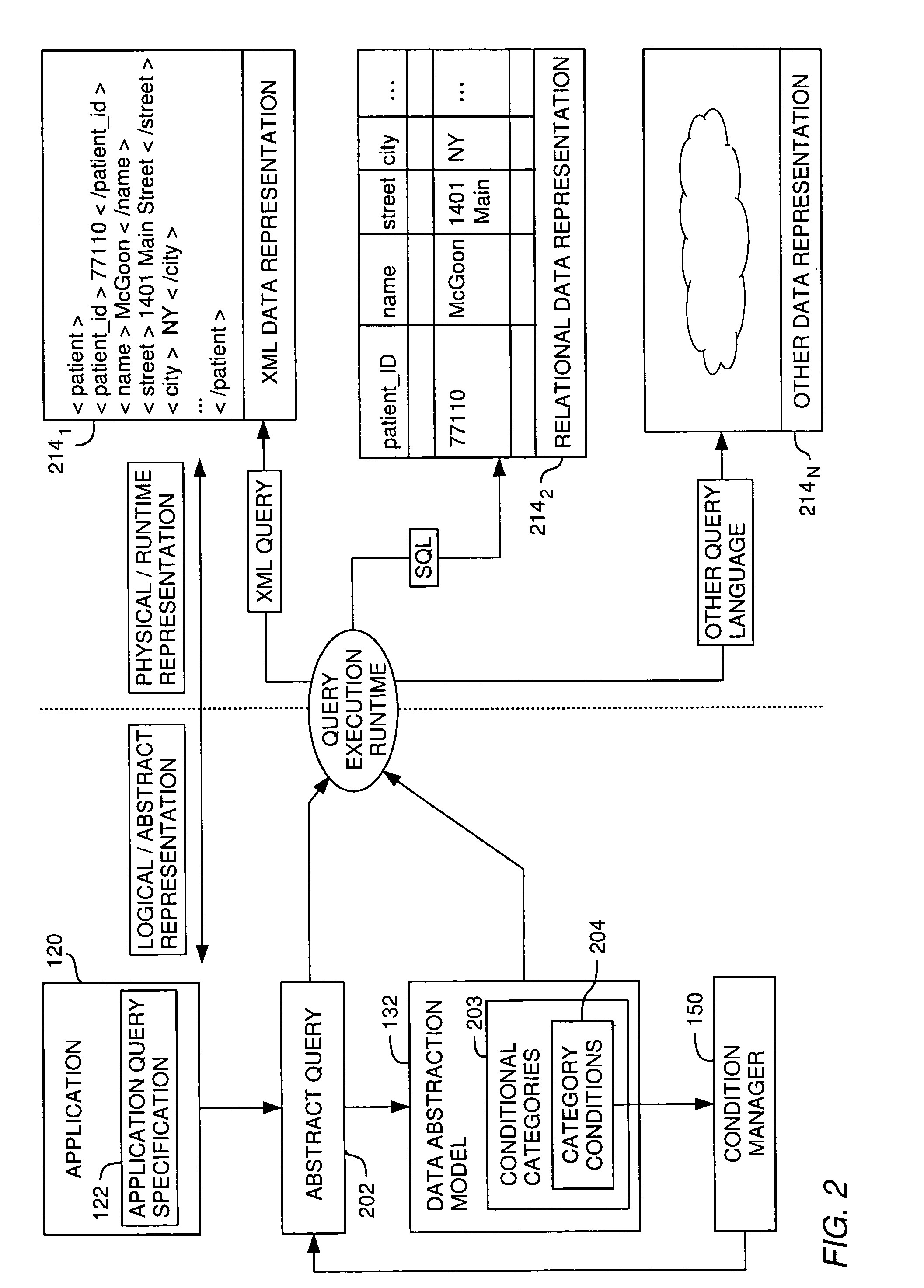[0014] Another embodiment provides a computer-implemented method of composing an abstract query against data in a database on the basis of a data abstraction model abstractly describing the data in the database. The method comprises displaying first user-selectable elements for constructing a first query condition of the abstract query. Each user-selectable element is displayed for a different node of a logical tree structure hierarchically representing the data abstraction model. Then, user selection of one or more of the first user-selectable elements for constructing the first query condition is received; and nodes from the logical tree structure for constructing a second query condition of the abstract query are identified. Which nodes are identified is dependent on the first query condition. For the identified nodes second user-selectable elements for constructing the second query condition of the abstract query are displayed. Then, user selection of one or more of the second user-selectable elements for constructing the second query condition is received. The first and second query conditions define selection criteria for selection of a specific set of the data from the database. The selection criteria are programmatically modified in response to construction of the second query condition on the basis of one or more predefined modification rules, whereby the specific set of the data is altered.
[0015] Still another embodiment provides a computer-implemented method of constructing queries, comprising displaying a first graphical user interface screen containing user-selectable query-building elements for constructing a first query condition of a query. The method further comprises receiving user selections of the user-selectable query-building elements to construct the first query condition. After constructing the first query condition, one or more additional graphical user interface screens are displayed, each containing user-selectable query-building elements for constructing another query condition of the query. The user-selectable query-building elements of each additional graphical user interface screen are determined by accessing a navigation tree defining which user-selectable query-building elements will be displayed on the basis of a user's previous selections of user-selectable query-building elements for the query. After construction of one or more given query conditions, the query is programmatically modified in response to construction of the given query condition on the basis of one or more predefined modification rules.
[0016] Still another embodiment provides a computer-readable medium containing a program which, when executed by a processor, performs operations for composing a query against data in a database. The operations comprise receiving user input for constructing a first query condition of the query. Then, user-selectable elements to display for constructing a second query condition of the query are identified. Which user-selectable elements are identified is dependent on the first query condition. The identified user-selectable elements for constructing the second query condition are displayed. Then, user selection of one or more of the displayed user-selectable elements for constructing the second query condition is received. The first and second query conditions define selection criteria for selection of a specific set of the data from the database. The selection criteria is programmatically modified in response to construction of the second query condition on the basis of one or more predefined modification rules, whereby the specific set of the data is altered.
[0017] Still another embodiment provides a computer-readable medium containing a program which, when executed by a processor, performs operations for composing an abstract query against data in a database on the basis of a data abstraction model abstractly describing the data in the database. The operations comprise displaying first user-selectable elements for constructing a first query condition of the abstract query. Each user-selectable element is displayed for a different node of a logical tree structure hierarchically representing the data abstraction model. Then, user selection of one or more of the first user-selectable elements for constructing the first query condition is received; and nodes from the logical tree structure for constructing a second query condition of the abstract query are identified. Which nodes are identified is dependent on the first query condition. Then, second user-selectable elements are displayed for the identified nodes for constructing the second query condition of the abstract query; and user selection of one or more of the second user-selectable elements for constructing the second query condition is received. The first and second query conditions define selection criteria for selection of a specific set of the data from the database. The selection criteria is programmatically modified in response to construction of the second query condition on the basis of one or more predefined modification rules, whereby the specific set of the data is altered.
[0018] Still another embodiment provides a computer-readable medium containing a program which, when executed by a processor, performs operations for constructing queries. The operations comprise displaying a first graphical user interface screen containing user-selectable query-building elements for constructing a first query condition of a query; and receiving user selections of the user-selectable query-building elements to construct the first query condition. After constructing the first query condition, one or more additional graphical user interface screens are displayed, each containing user-selectable query-building elements for constructing another query condition of the query. The user-selectable query-building elements of each additional graphical user interface screen are determined by accessing a navigation tree defining which user-selectable query-building elements will be displayed on the basis of a user's previous selections of user-selectable query-building elements for the query. After construction of one or more given query conditions, the query is programmatically modified in response to construction of the given query condition on the basis of one or more predefined modification rules.
[0019] Still another embodiment provides a system comprising a display device, a navigation structure, one or more modification rules, a user interface and a condition manager. The navigation structure defines predefined navigation paths for users. The one or more modification rules define application of modifications to a query condition on the basis of another query condition. The user interface is configured for composing a query against data in a database. The condition manager is configured to receive user input for constructing a first query condition of the query from the user interface. Then, the condition manager accesses the navigation structure to identify user-selectable elements to display for constructing a second query condition of the query, wherein each navigation path specifies which of a plurality of user-selectable elements to display dependent on the first query condition. The identified user-selectable elements for constructing the second query condition are displayed on the display device. Then, user selection of one or more of the displayed user-selectable elements for constructing the second query condition is received from the user interface, wherein the first and second query conditions define selection criteria for selection of a specific set of the data from the database. The selection criteria are programmatically modified in response to construction of the second query condition on the basis of one or more corresponding modification rules, whereby the specific set of the data is altered.
 Login to View More
Login to View More  Login to View More
Login to View More 


